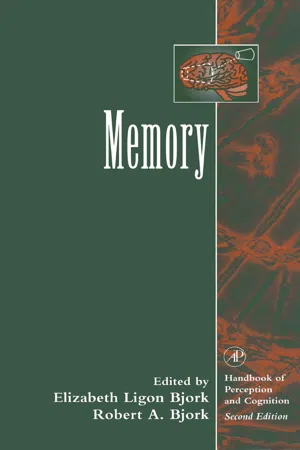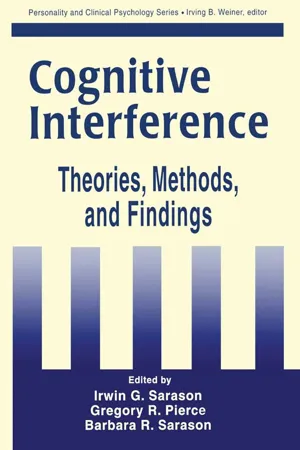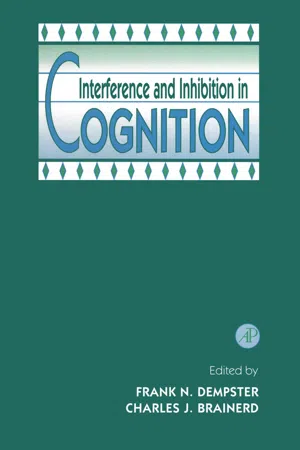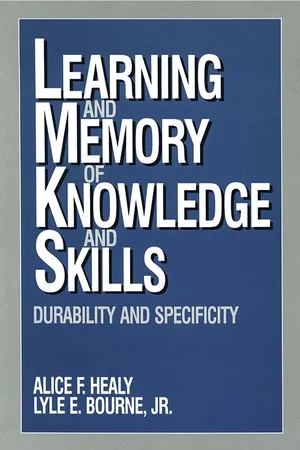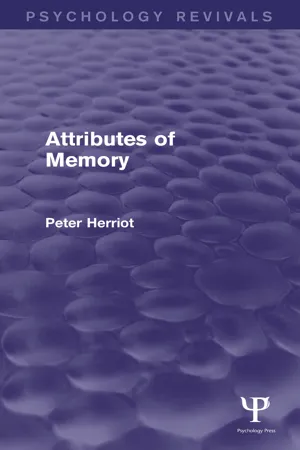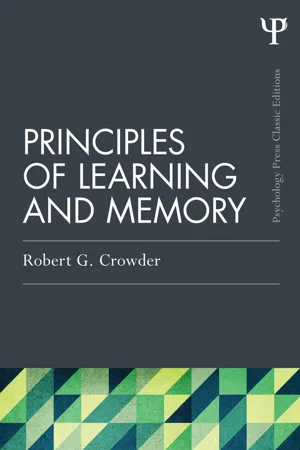Psychology
Studies on Interference
"Studies on Interference" in psychology refer to research on how the presence of competing information can disrupt memory recall and cognitive processes. This interference can occur when new information interferes with the retrieval of old information (proactive interference) or when old information interferes with the encoding of new information (retroactive interference). Understanding interference is important for improving memory and learning strategies.
Written by Perlego with AI-assistance
Related key terms
1 of 5
6 Key excerpts on "Studies on Interference"
- eBook - PDF
- Elizabeth Ligon Bjork, Robert A. Bjork(Authors)
- 1996(Publication Date)
- Academic Press(Publisher)
Interference refers to the impaired ability to remember an item when it is similar to other items stored in memory. Interest in interference was initi- ated at the turn of the century, when G. E. Mueller and Pilzecker (1900) reported the first empirical study of retroactive interference. This observa- tion ultimately led to a program of research lasting seventy years, the pri- mary focus of which was to explain the substantial forgetting associated with interference. A core advance coming out of this classical era was a simple characterization of the basic situation of interference as competition between items sharing a common retrieval cue. According to this idea, attaching additional memory responses to a particular stimulus reduces recall performance on target items because those additional items compete with targets upon presentation of their shared stimulus. This core idea permeates modern theoretical work in a variety of domains, although the terms used to characterize competition may vary in each case. Indeed, the last twenty years have illustrated that these elementary dynamics apply to a variety of cognitive tasks in which one must select between multiple con- currently activated mental representations, such as: (1) trying to retrieve a specific episode from our past; (2) trying to retrieve facts that we encoded into semantic memory; (3) performing the seemingly effortless task of re- trieving a single word's meaning, spelling, or pronunciation; (4) trying to select, for additional analysis, an object from among other objects in our 8 Interference and Inhibition in Memory Retrieval 303 perceptual environment; and (5) trying to retrieve sequentially the informa- tion needed to form a coherent sentence or argument or to solve a problem. Many theories have been proposed to explain why associating additional items to a retrieval cue might render those items more susceptible to inter- ference. - eBook - ePub
Cognitive Interference
Theories, Methods, and Findings
- Irwin G. Sarason, Gregory R. Pierce, Barbara R. Sarason, Irwin G. Sarason, Gregory R. Pierce, Barbara R. Sarason(Authors)
- 2014(Publication Date)
- Routledge(Publisher)
In this chapter, research on cognitive interference is examined, both as it arises in specific classes of situations and as it manifests itself across diverse settings. The first section is a review of research on cognitive interference in three domains: academic, social, and athletic situations. Next is an examination of the few studies that have conceptualized and investigated cognitive interference as a personality characteristic, one that is presumed to influence cognitive and overt behavior across a broad range of situations. Finally, an agenda is developed for future research and theory development in the area of cognitive interference.SITUATIONAL APPROACHES TO COGNITIVE INTERFERENCE
Research on cognitive interference has tended to be domain specific; in other words, investigators have typically been concerned with conceptualizing cognitive interference as it manifests itself in a particular class of situations. For example, much of the work on intrusive thoughts has stemmed from studies of test anxiety; cognitive interference was conceptualized as a mediating mechanism by which test anxiety might influence performance in academic situations. Similarly, investigations of social anxiety have, understandably, focused primarily on the effects of cognitive interference in settings with a strong interpersonal element. Studies of cognitive interference in athletic situations have also been characterized by a domain specific approach. Common to each of these areas of research is an emphasis on an individual differences variable that determines whether a person experiences cognitive interference in a particular type of situation.Test Anxiety
The bulk of research on cognitive interference has examined its role in test taking situations (Sarason, 1980; Smith, this volume). Intrusive thoughts occurring in academic situations are hypothesized to be a function of test anxiety-people’s characteristic level of anxiety in academic situations. The construct of test anxiety is multidimensional. For instance, Sarason (1984) developed a factorially derived, self-report instrument, the RTT Questionnaire, to assess four facets of individuals’ habitual responses to test taking situations: (a) tension, (b) worry, (c) test-irrelevant thinking, and (d) bodily symptoms. The RTT tension, worry, and test-irrelevant thinking scales—but not the Bodily Symptoms Scale—have been shown to be good predictors of intrusive thoughts experienced in academic situations (Hunsley, 1987; Sarason, 1984; Sarason, Sarason, Keefe, Hayes, & Shearin, 1986). These findings are consistent with the observation that physiological arousal in test situations is universal, rather than specific to those who are highly test anxious (Hollandsworth, Glazeski, Kirkland, Jones, & Van Norman, 1979; Holroyd, Westbrook, Wolf, & Badhorn, 1978); it also fits with a cognitive orientation to the conceptualization of test anxiety. - eBook - PDF
- Charles J. Brainerd, Frank N. Dempster(Authors)
- 1995(Publication Date)
- Academic Press(Publisher)
Similarly, Neumann and Deschepper (1992) explored the relationship between susceptibility to interference and inhibition efficien- cy in a negative-priming task. They found that the fastest responders in a se- lective-attention task (an interference measure) showed greater levels of nega- tive priming (an inhibition measure). While interference and inhibition are related constructs, cognitive devel- opmental theories distinguish between them, with different approaches ad- dressing primarily inhibition (e.g., Bjorklund & Harnishfeger, 1990; Hasher & Zacks, 1988) or interference (e.g., Brainerd & Reyna, 1993; Dempster, 1993), and with different explanations and predictions for the two concepts. Looking first at inhibition, cognitive theories define it as an active suppres- sion process that keeps irrelevant information from entering and being main- tained in working memory, and from disrupting cognitive processing in gener- al. Deficits in inhibition impair processing, resulting in the activation, maintenance, and retrieval of irrelevant information. Measures of inhibition include negative priming, intrusions in memory, and activation of relevant and irrelevant information during cognitive processing. Turning to the interference construct, cognitive theories define it as cog- nitive competition among multiple stimuli, processes, or responses. Unlike in- hibition, interference does not necessarily involve the active suppression of cognitive processes or contents. Interference disrupts processing because it produces bottlenecks, during which selection procedures must isolate the processes that will be executed, and the response that will be produced. Inter- ference also disrupts performance by making it more difficult to access low- memory-strength or verbatim traces, a point that is considered at length in Chapter 4 by Brainerd and Chapter 2 by Reyna, this volume. - eBook - PDF
Learning and Memory of Knowledge and Skills
Durability and Specificity
- Alice F. Healy, Lyle E. Bourne, Alice F. Healy, Lyle E. Bourne(Authors)
- 1994(Publication Date)
- SAGE Publications, Inc(Publisher)
degree. Thanks are extended to Dr. John S. Werner and Dr. Veme Keenan for serving on the dissertation committee. Thanks are also due to Deborah Clawson for writing the computer programs for the on-line experiments, and to Bill Marmie and Cheri King for help with the preparation of the figures and the formatting of the manuscript. K. Anders Ericsson is currently at Florida State University. Correspondence should be addressed to Vivian Schneider, Department of Psychology, University of Colorado, Campus Box 345, Boulder, CO 80309-0345. 95 H igh contextual interference slows learning but often produces supe-rior long-term memory and greater intertask transfer (e.g., Battig, 1972, 1979). For example, increasing the similarity of items to be learned or varying the processing requirements from trial to trial interferes with acquisition but aids retention and transfer. According to Battig (1972, 1979), contextual interference must be overcome by deeper cognitive processing so that items thus affected will be learned more slowly. But if well learned initially, the same items are retained as well as, or better than, the low-interference items. This finding is of clear importance to the study of long-term skill retention because it implies that the methods used to optimize performance during training are not necessarily those that opti-mize performance during subsequent retention tests. One of the methods of producing contextual interference is by using random, as opposed to blocked, practice schedules for acquisition. Prac-tice in a task domain is often organized into blocks of trials, each block consisting of only one of several parts of the whole task—what we refer to as blocked practice. Practice in the task domain can also be organized in such a way that all the different parts of the whole task are randomly intermixed across trials. - eBook - ePub
- Peter Herriot(Author)
- 2013(Publication Date)
- Psychology Press(Publisher)
Chapter 7 Past, present and future 7.1 Recent historical perspective 7.1.1 Interference theoryThe language predominantly used in experimental psychology prior to 1960 or so was that of stimuli, responses, and the learned associations between them. Memory performance was therefore seen as the product of learning — could one on a subsequent occasion produce a response to a stimulus having learned the association between the two on a previous occasion? When it became clear that there were many occasions when one could not, this fact required explanation. For, given the paradigm of learning theory, the non-availability of a response once learned is something which has to be explained. Therefore the early emphasis was on forgetting rather than remembering, and the basic technique was that of paired-associate learning.Two early concepts in the effort to explain forgetting were those of decay and interference. (For an introduction to interference theory see Cermak (1972), and for comprehensive reviews of interference theory and research see Postman (1969) and Postman and Underwood (1973).) In brief, interference theory is based upon the idea that preceding or subsequent events interfere with one’s memory of the to-be-recalled material. A typical retroactive interference design has subjects learn paired-associate list A, learn B, have a certain period of time out, recall A. A proactive design has subjects learn B, learn A, time out, recall A. Control groups have no task B.It was found that while proactive interference had the same effect whatever the time out, retroactive interference had a lesser effect after forty-eight than after five hours; that is, there was recovery (Underwood, 1948). This suggested that there was something specific about the retroactive design (in which subjects learned the interfering material after - eBook - ePub
Principles of Learning and Memory
Classic Edition
- Robert G. Crowder(Author)
- 2014(Publication Date)
- Psychology Press(Publisher)
8The Interference Theory of Forgetting in Long-term MemoryIt is widely agreed that the large set of evolving propositions and principles known as interference theory is the most comprehensive theoretical system in the field of human learning and memory; the relevant objective analyses would probably show it to be one of the two or three most extensive theoretical efforts within all of experimental psychology. Interference theory was originally directed at the problem of forgetting but it soon became the framework for process theories of human learning as well.At this point in the book we are turning from chapters on coding analysis (visual and auditory sensory memories, speech coding, and visual imagery) and on short-term memory processing (primary memory, forgetting of individual items) to chapters concerning long-term learning and memory processing (forgetting theory, effects of repetition, and organizational processes). The choice has been to begin this coverage with the chronologically earliest research tradition. A considerably longer historical perspective on the study of learning and memory is offered in Chapter 12 .Historically, three periods in the development of interference theory may be distinguished and they serve to organize the present coverage. The first period, beginning around 1900, was marked mainly by the influence of McGeoch (1942) and saw the articulation of a theory of forgetting based on competition, at the time of retrieval, between responses associated with a common stimulus. In 1940 Melton and Irwin proposed a dynamic factor in forgetting analogous to experimental extinction, unlearning, and the next 20 years were largely devoted to elaborating and verifying implications of this hypothesis; this second period may be said to have culminated with an important review paper by Postman in 1961 called “The Present Status of Interference Theory.” The third period began shortly thereafter, and has been characterized by increasing doubts concerning the centrally important unlearning hypothesis and by the proposal of additional factors.
Index pages curate the most relevant extracts from our library of academic textbooks. They’ve been created using an in-house natural language model (NLM), each adding context and meaning to key research topics.
